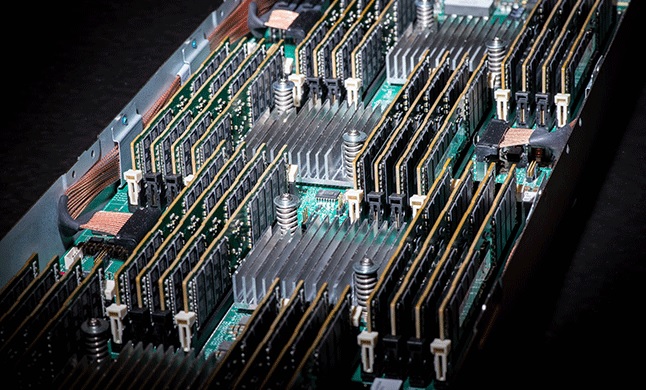Over the years, we have grown accustomed to CPUs being the driving force behind computing platforms and that trend remains true today. However, things may be very different in the future as this week, Hewlett-Packard Enterprise (HPE) showed off the world's first memory-driven computing architecture, which puts memory at centre stage to achieve performance and efficiency gains not possible today.
HPE's demonstration is more of a proof of concept than a final product but the prototype represents a major milestone in the company's efforts to transform the architecture all computers have been built on for decades. The memory-driven computing architecture is being developed as part of The Machine research program, which has been put in place to push computing forward to keep up with demands for years to come.
Image credit: HPE
The proof of concept prototype was brought online back in October and shows the core building blocks that allow the new architecture to work:
- Compute nodes accessing a shared pool of Fabric-Attached Memory;
- An optimized Linux-based operating system (OS) running on a customized System on a Chip (SOC);
- Photonics/Optical communication links, including the new X1 photonics module, are online and operational; and
- New software programming tools designed to take advantage of abundant persistent memory.
According to simulations run on the prototype, the speed of this new memory-driven platform would improve current computing by “multiple orders of magnitude” and for some workloads can be up to 8000 times faster. HPE expects to achieve similar results to this as it expands the prototype with more nodes and memory.
Discuss on our Facebook page, HERE.
KitGuru Says: It is hard to imagine a world where CPUs aren't necessarily the driving force behind the computing platform but that appears to be what HPE is aiming for and according to its early results, things are off to a good start on that front. However, it may be a long time before we see this sort of technology appear in any form of consumer product.
 KitGuru KitGuru.net – Tech News | Hardware News | Hardware Reviews | IOS | Mobile | Gaming | Graphics Cards
KitGuru KitGuru.net – Tech News | Hardware News | Hardware Reviews | IOS | Mobile | Gaming | Graphics Cards




It’d be cool to have an idea of what types of workloads are most affected. I assume straight-up number crunching based on the verbiage of the article. If that’s the case, would be neat to see how it performs for physics computations. I’d be interested to see if it would be feasible to (eventually) use one of these as a networked physics processor for a LAN or the like. Probably not the intended design, but it’s always fun to use something for a task it isn’t meant to do.
If that’s the case it would be interesting to see how this solution would hold up against GPGPU, either in cost effectiveness or time efficiency
Databases is a big one, analytics another, which would benefit from having a huge pool of high-speed, low-latency memory.
I’m with you on that one. Unfortunately, HPE didn’t specify any specific workloads so even we aren’t quite sure. However, I would imagine number crunching and analytics would play a big part in it.
Google is paying 97$ per hour! Work for few hours and have longer with friends & family! !mj94d:
On tuesday I got a great new Land Rover Range Rover from having earned $8752 this last four weeks.. Its the most-financialy rewarding I’ve had.. It sounds unbelievable but you wont forgive yourself if you don’t check it
!mj94d:
➽➽
➽➽;➽➽ http://GoogleFinancialJobsCash94MarketSourceGetPay$97Hour… ★★✫★★✫★★✫★★✫★★✫★★✫★★✫★★✫★★✫★★✫★★✫★★✫★★✫★★✫★★✫★★✫★★✫★★::::::!mj94d:….,…..
Google is paying 97$ per hour! Work for few hours and have longer with friends & family! !mj88d:
On tuesday I got a great new Land Rover Range Rover from having earned $8752 this last four weeks.. Its the most-financialy rewarding I’ve had.. It sounds unbelievable but you wont forgive yourself if you don’t check it
!mj88d:
➽➽
➽➽;➽➽ http://GoogleFinancialJobsCash88MediaServerGetPay$97Hour… ★★✫★★✫★★✫★★✫★★✫★★✫★★✫★★✫★★✫★★✫★★✫★★✫★★✫★★✫★★✫★★✫★★✫★★::::::!mj88d:….,…..